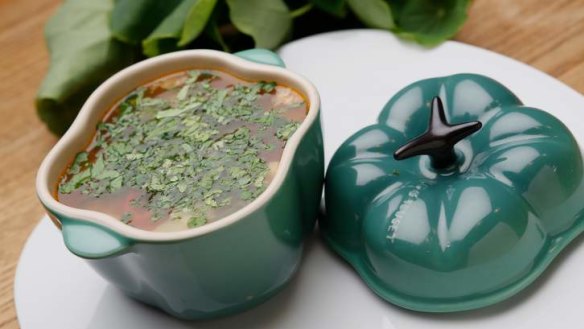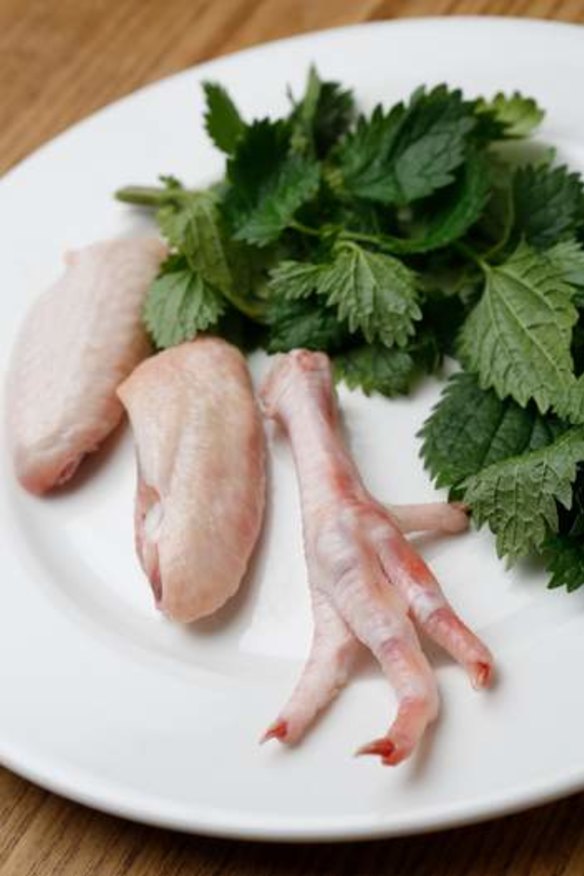Soup from scratch

Good old-fashioned soup – the stuff that's made with a few thrifty cuts of meat, a handful of vegetables and a gelatin-rich bone broth – is the sustenance of all traditional diets and the staple food that has allowed armies to thrive and families to grow.
Home-made soup is a means of making simple ingredients stretch a bit further, whereby offcuts of meat are transformed into a delicious protein source, and the otherwise inedible bones and connective tissue are reformed into something nutritious and satisfying.
Our throwaway lifestyle might not be suited to long hours spent watching a pot simmer. Why would you cook soup from scratch when you can easily buy it in a can, crumble it from a cube, or zap it in a microwave?
The reasons for taking the age-old path are many – the process of making soup from scratch, with all the essential ingredients such as meat stock, vegetables and herbs, confers not only nutritional benefits, but cuts food waste.
Soup remains one of the easiest and most cost-effective dishes to prepare. Armed with a cook pot, wooden spoon, and perhaps a handheld blender, you've got yourself a meal by simply throwing together, in no particular order, a few ingredients that you can source from your freezer or back garden.
Good soup is frugal soup

Good soup at home can be made cost effectively with a few staple ingredients. Try some poor man's foods such as dried beans or lentils. Add some of those tired-looking vegetables you have tucked away at the back of the fridge. Try some wild herb pickings from the garden, and don't hold back on a few wild and friendly weeds such as stinging nettle or comfrey.
But the base is the most important part, as it is really the stock that maketh the soup. So it's worth putting in a little time, making some stock in advance and storing it in your fridge or freezer.
Legendary French chef and author Auguste Escoffier once wrote that that "stock is everything in cooking. Without it, nothing can be done."
Stock remains the vital component to French soups, sauces and stews. In large French commercial kitchens, a "saucier" is still employed to be solely responsible for the sauces made with a base of gelatin-rich stocks.
The unique flavour of home-made stock has the special taste known as "unami", which the Japanese describe as "deliciousness". This unique flavour (known as the fifth taste that can be detected on the tongue) is attributed to the abundance of glutamatic acid that is naturally present in stock.
While you may not have heard of glutamic acid, you will no doubt be familiar with the name of the artificial chemical compound that the food processing industry uses to try to imitate the satisfying mouth feel and flavour of home-made bone broth that glutamatic acid produces – it is known as monosodium glutamate or MSG (look for E621, hydrolysed proteins or MSG).
There is a reason why a good stock or bone broth features prominently in kitchen anecdotes and home remedies. When prepared correctly, it is extremely nourishing. Of particular note is the presence of gelatin, which is derived from collagen.
Collagen is a connective-tissue protein that gives strength and suppleness to muscles, tendons, skin and bones. Good stock is said to confer healing benefits on the stomach and intestinal tract (hasn't your mother ever given you a pot of soup when you're sick?), and also benefit the joints and connective tissue.
The old wives tale of "Jewish penicillin" curing a cold or stomach bug refers to a gelatin-rich chicken broth made with chicken feet, carcasses and necks, which are rich in collagen.
Stock is also an excellent source of minerals, in particular, calcium, phosphorus and potassium, which are easily absorbed in their hydrolysed form.
Making stock is really about making the most of our less fashionable cuts – look for bone joints at your local butcher or buy direct from a farmer who may have access to all these cuts.
Ask for shank, marrow or rib, chicken carcasses or wingettes. Feet are one of the richest sources of gelatin, so if you are able to find hooves, knuckles, chicken or pig's feet you are in business.
Heads are used for stock-making in many Asian recipes, and rooster combs are an excellent source of gelatin.
These can also be frozen if you need to buy them in bulk, and they are often very cheap. It is a travesty that so many of these precious and nutritious off-cuts go to waste.
The meat that you use in soup should be the less fashionable – the tougher cuts that are suited to long, slow, gentle cooking, as they will benefit from the lengthy time in the pot.
Using older animals – an old laying hen that is no longer useful or a rooster with too much testosterone, is a good way to waste less. If you shop directly from farmers, or have a good relationship with your butcher, you should be able to access them, and they will often be very cheap.
Dried beans and lentils cooking tip:
For best preparation, buy them in their dried form (this is far cheaper – a can will cost you three to four times more. They also taste far better). Soak beans and pulses overnight in filtered water with a half teaspoon of bicarbonate of soda. Lentils don't require pre-soaking, so you can skip this step. Rinse well. Then cook in fresh water for 45 minutes or until soft. Drain. The cooking water can be re-used as a vegetable stock.
Frugavore Chicken Stock:
Ingredients:
Chicken carcasses, necks, wingettes and feet – enough to three-quarter fill a stock pot. The ideal ratio is 80 per cent carcasses and necks, and 20 pr cent wingettes and feet.
A few each of carrots, celery, turnips – don't worry if they are tired or saggy looking.
1 tablespoon apple cider vinegar.
A few springs of garden herbs: rosemary, thyme, sage
Whatever wild herbs you can find – nettle, borage, catnip etc all work well.
Kombu or dried seaweed can also be added for extra minerals.
Method:
Place all ingredients in a pot. Cover with cold water. Bring to a boil. Reduce to a simmer and cook gently for 12-24 hours.
Drain. Discard solids (try disposing of them in a bokashi bin or green cone), and keep the liquid, which can be refrigerated or frozen.
If you have additional meat on the bones, this can be saved and used in a terrine, casserole or sandwich.
Frugavore winter soup
This is a deliciously hearty soup that uses up all the bits. It will feed a large family, probably with leftovers.
Ingredients:
1 whole free-range chicken, small size (if you use a larger bird, you will have excess meat, but you just need to take this out in the last step)
Feet and neck from your chook, or use 1 pig's foot
A few sprigs of rosemary
2 onions, finely chopped
3/4 cup dried chickpeas that have been soaked overnight with a pinch of bicarbonate of soda
1 tablespoon vinegar
3 zucchini, sliced
3-4 carrots, sliced
1/4 medium-sized cabbage that has been finely sliced or shredded
1 bunch of nettles, stalks removed, coarsely chopped (optional)
a pinch of saffron threads
1-2 tablespoons harissa
1 large bunch each of parsley and coriander, finely chopped
Place the chicken in a large cooking pot with the chicken feet, vinegar, rosemary, chickpeas and onions. Cover with cold water. Bring to the boil, then reduce to a gentle simmer. Gently cook until chickpeas are soft and meat is well cooked.
Remove the chicken, neck and feet from the cooking pot, but keep the water gently cooking. You need to separate all the meat from the bones. Place all the bones, feet and non-edible bits in a separate cooking pot, cover with water and continue to cook as a stock. Shred the meat into bite-size pieces and set aside.
Place all vegetables, nettles and saffron threads into the first soup pot with the cooking water. Cook until soft, then add the meat and season to taste. Serve with a generous sprinkling of coriander and parsley.
A harissa sauce can be made by removing half a cup of liquid from the pot, stirring through some harissa, then pouring over each individual soup bowl.
The remaining bones can continue cooking as a stock which can be added to the soup, or reserved for a later purpose.
The best recipes from Australia's leading chefs straight to your inbox.
Sign up